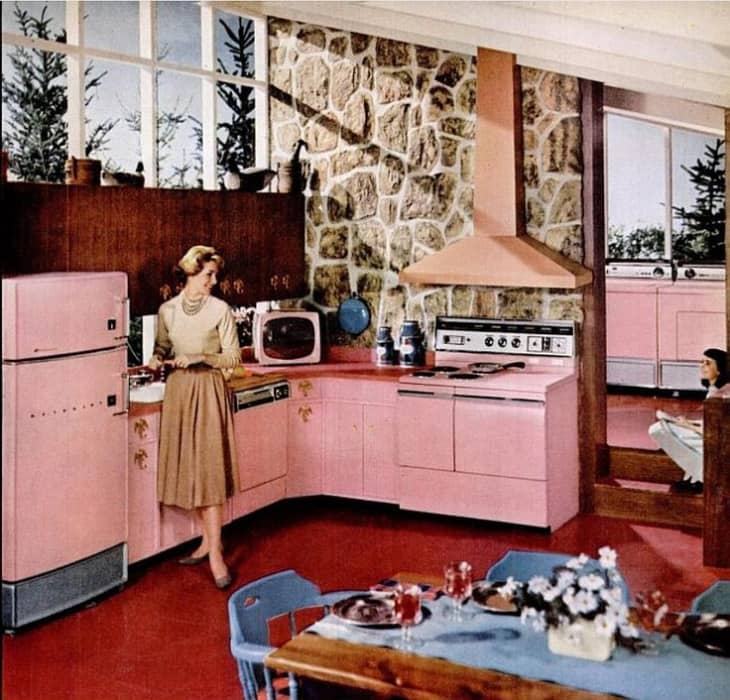How A Decade of Domesticity Changed Our Nation’s Kitchens

It’s the 1950s. The war is over, and the United States is enjoying a wave of unprecedented prosperity. Millions of GIs returned, eager for the comforts of home that they had been missing, and everyone settled down to a kind of nationwide nesting. Record numbers of homes were being built in the newly developed suburbs, and the center of all those homes was the kitchen.
The new, modern American kitchen took the form that had been established at the Bauhaus way back in the 1920s — built-in cabinets, with a long, continuous countertop above, and appliances integrated into the cabinets for a seamless look. People who couldn’t afford to buy a new house, or to replace their kitchen all in one go, were encourage to modernize their kitchen bit by bit, replacing their old piecemeal kitchens with new, modern cabinetry — starting with the sink unit.
By the 1940s, refrigerators had become a common feature in American kitchens. Appliance designers in the 1950s experimented with some refrigerator designs that might seem rather unusual to us now, like the 1952 GE wall-mounted version, which replaced a section of upper cabinets. The pink unit above, grandly titled the ‘GE Refrigeration Center’, combined a wall-mounted fridge with pull-out refrigerator (or freezer) drawers that were designed to match the rest of the cabinets.
Steel kitchen kitchen cabinets were very common in the 1950s, as manufacturers looked for ways to turn steel factories that produced weapons for the war to more domestic purposes. There were quite a few different manufacturers, including GE, who made both appliances and cabinets. GE also made the “cabinettes” you see above — little tiny metal cabinets made to mount under an upper cabinet (or on the backsplash).
Throughout the ’50s, designers and homeowners embraced color in the kitchen, although these colors were softer than the ones commonly seen in ’30s and ’40s kitchens. While kitchens in the ’30s and ’40s often featured bolder colors like black, red, or green, the ’50s was dominated by soft shades of blue, pink, and yellow — candy-colored cabinets with appliances to match.
In the 1960s, wood replaced steel as the cabinet material of choice, and wood tones began to creep their way back into the kitchen. Colored appliances were still quite prevalent, but the favored colors began to shift, from pastels to more bold, robust colors like harvest yellow and avocado green, which matched better with wood tones.
The dishwasher was a new introduction to kitchens in the 1950s and 1960s. Although many of the pictured kitchens (most of which are from ads) show them, they wouldn’t become a common feature of American homes until the 1970s.
The transition from the ’50s to the ’60s marks a shift, from kitchens that feel distinctly ‘retro’ to the kind of kitchens you probably remember from your childhood (or just from a lot of Apartment Therapy ‘before’ photos). It seems strange to us to imagine someone ripping out a charming 1950s or 1940s kitchen to ‘update’ it with dark wood cabinets and greenish appliances, just as it will probably, someday, seem strange to future generations to imagine us tearing out wood cabinets to replace them with all white, subway tile, and stainless appliances. As we approach the modern era, the differences in kitchens become less technological and much more stylistic — but style is a fickle thing, and even if it’s only skin deep, the look of the kitchen is always changing.
For further reading:
- A gallery of 1950s kitchens from Mid Century Home Style
- A history of steel kitchen cabinets from Retro Renovation
- A gallery of 1960s kitchens (and bathrooms) from Retro Renovation